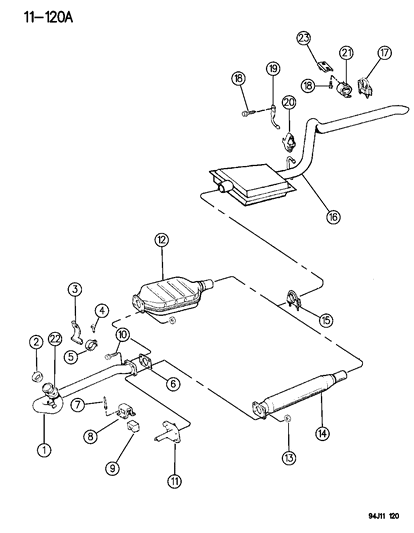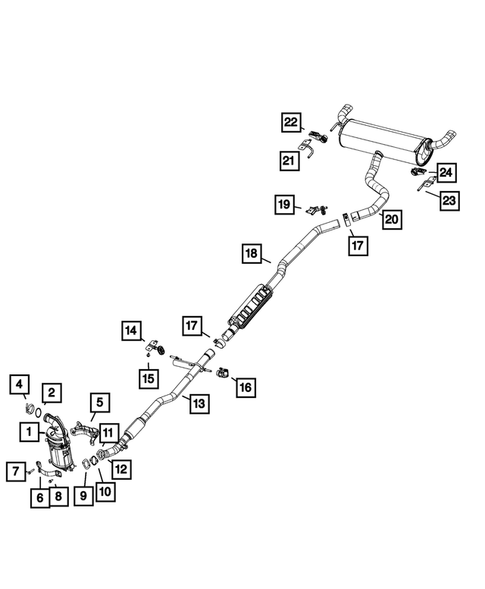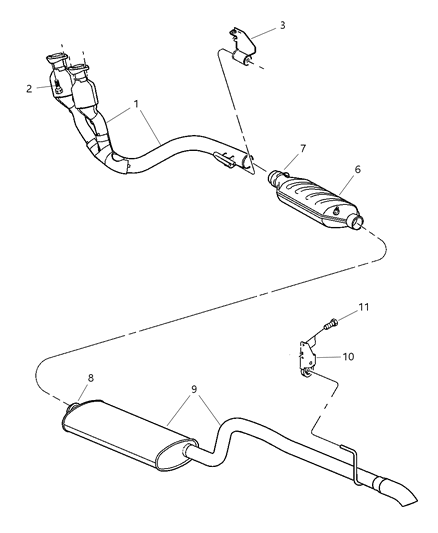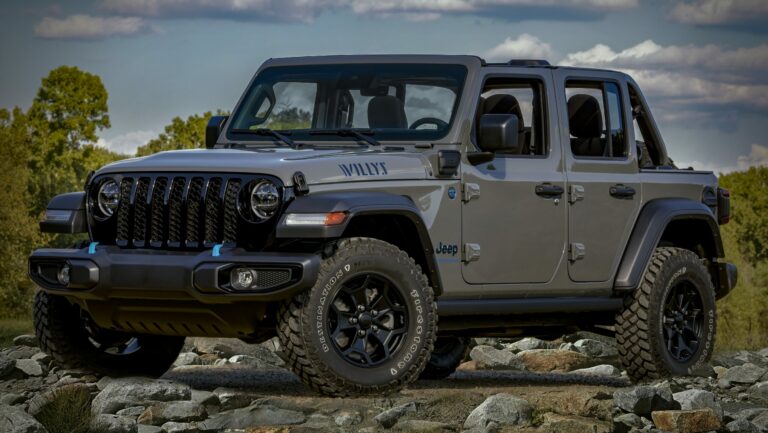Jeep Cherokee Exhaust System: A Comprehensive Guide
Jeep Cherokee Exhaust System: A Comprehensive Guide jeeps.truckstrend.com
The iconic Jeep Cherokee, a vehicle renowned for its rugged capability and enduring appeal, relies heavily on a properly functioning exhaust system. Far more than just a pipe that vents fumes, the exhaust system is a complex network of components crucial for the vehicle’s performance, environmental compliance, and overall driving experience. Whether you own a classic XJ, a modern KL, or any generation in between, understanding your Jeep Cherokee’s exhaust system is key to maintaining its health and unlocking its full potential.
This comprehensive guide will delve into every aspect of the Jeep Cherokee exhaust system, from its fundamental components and critical functions to common issues, maintenance tips, and the exciting world of aftermarket upgrades.
Jeep Cherokee Exhaust System: A Comprehensive Guide
The Anatomy of Your Jeep Cherokee’s Exhaust System
Before diving into its functions and maintenance, let’s dissect the primary components that constitute a typical Jeep Cherokee exhaust system:
- Exhaust Manifold/Headers: Connected directly to the engine’s cylinder head, the exhaust manifold (or headers, in performance applications) collects exhaust gases from each cylinder. It’s designed to efficiently channel these hot gases into a single pipe. On older Cherokees, cracked manifolds are a common issue.
- Oxygen Sensors (O2 Sensors): Strategically placed before and after the catalytic converter, these sensors monitor the oxygen content in the exhaust gases. They provide crucial data to the engine’s computer (ECU), allowing it to optimize the air-fuel mixture for efficiency and reduced emissions.
- Catalytic Converter: A vital emission control device, the catalytic converter transforms harmful pollutants (carbon monoxide, hydrocarbons, nitrogen oxides) into less harmful substances (carbon dioxide, water vapor, nitrogen) through chemical reactions catalyzed by precious metals like platinum, palladium, and rhodium.
- Resonator (Optional): Found in some configurations, the resonator is a chamber designed to reduce specific frequencies of exhaust noise, often targeting drone or unwanted harshness, contributing to a smoother exhaust note.
- Muffler: The primary noise-reduction component. The muffler contains a series of chambers, baffles, and/or perforated tubes that dissipate sound waves, significantly quieting the engine’s exhaust note to acceptable levels.
- Exhaust Pipes: A series of pipes connect all the components, routing exhaust gases from the engine, under the vehicle, and out through the tailpipe. These include the downpipe (connecting manifold to cat), mid-pipe, and tailpipe.
- Exhaust Hangers and Mounts: Rubber or metal hangers securely suspend the entire exhaust system from the vehicle’s undercarriage, isolating vibrations and allowing for movement while preventing contact with other components.

Functions and Importance: Why a Healthy Exhaust Matters
The exhaust system plays a multifaceted role in your Jeep Cherokee’s operation:

- Emission Control: This is perhaps its most critical environmental function. The catalytic converter, aided by O2 sensors, drastically reduces harmful pollutants, ensuring your Cherokee complies with environmental regulations and minimizes its ecological footprint.
- Noise Reduction: Without a muffler, your Jeep would be deafeningly loud. The exhaust system is expertly engineered to dampen engine noise, providing a comfortable and legal driving experience.
- Engine Performance: A well-designed exhaust system reduces back pressure, allowing exhaust gases to exit the engine efficiently. This "breathing" ability directly impacts horsepower, torque, and throttle response. Conversely, a clogged or restrictive exhaust can choke your engine, leading to power loss.
- Fuel Efficiency: An efficient exhaust system contributes to optimal engine operation, which in turn can lead to better fuel economy. Issues like exhaust leaks or a clogged catalytic converter can force the engine to work harder, consuming more fuel.
- Safety: By directing noxious exhaust gases (like carbon monoxide) away from the passenger cabin, the exhaust system ensures the safety of the vehicle’s occupants.

Common Issues and Symptoms to Watch For
Even the robust Jeep Cherokee is susceptible to exhaust system problems. Knowing the symptoms can help you diagnose and address issues promptly:
- Rust and Corrosion: Due to exposure to water, salt, and extreme temperatures, exhaust components (especially pipes and mufflers made of aluminized steel) are prone to rust, leading to holes and leaks.
- Exhaust Leaks: A tell-tale sign is a hissing, ticking, or tapping sound, especially upon acceleration. Leaks reduce efficiency, increase noise, and can allow dangerous fumes into the cabin.
- Rattling Noises: This often indicates loose or broken exhaust hangers, a detached heat shield, or internal muffler/resonator baffle collapse.
- Increased Noise/Loudness: A sudden increase in exhaust volume, or a new aggressive rumble, usually points to a hole in the muffler or a significant leak elsewhere in the system.
- Decreased Performance/Fuel Economy: A clogged catalytic converter or severe exhaust restriction can lead to noticeable power loss, sluggish acceleration, and reduced MPG.
- Check Engine Light (CEL): A lit CEL can often be traced to failing O2 sensors or a faulty catalytic converter. Diagnostic trouble codes (DTCs) will usually confirm the issue.
- Unusual Smells: A rotten egg smell (sulfur) often signifies a failing catalytic converter. Exhaust fumes inside the cabin indicate a serious leak that needs immediate attention.
Maintenance and Care for Longevity
Proactive maintenance can significantly extend the life of your Jeep Cherokee’s exhaust system:
- Regular Visual Inspections: During oil changes or tire rotations, take a few minutes to visually inspect the exhaust system for signs of rust, holes, loose hangers, or dents. Pay close attention to welds and connection points.
- Listen for Changes: Get accustomed to your Cherokee’s normal exhaust sound. Any new rattles, hisses, or increased loudness warrant investigation.
- Address Rust Early: While minor surface rust is normal, deep rust or pitting should be monitored. In areas with heavy road salt, consider applying rust-inhibiting coatings if accessible.
- Check Hangers and Mounts: Ensure all rubber isolators and metal hangers are intact and securely holding the system. Replace any that are cracked, worn, or missing.
- Professional Inspections: Include an exhaust system check as part of your regular vehicle service. Mechanics can spot issues you might miss and have specialized tools for diagnosis.
Upgrading Your Jeep Cherokee Exhaust System
Upgrading your Jeep Cherokee’s exhaust system is a popular modification, offering a range of benefits from improved performance to a more aggressive sound and enhanced aesthetics.
Why Upgrade?
- Performance Gains: Aftermarket systems, especially headers and cat-back kits, are often designed with larger diameter piping and less restrictive mufflers to improve exhaust flow, resulting in modest gains in horsepower and torque.
- Enhanced Sound: This is often the primary motivator. Aftermarket mufflers and resonators can dramatically change your Cherokee’s exhaust note, from a deep, mellow rumble to a throaty, aggressive growl.
- Improved Aesthetics: Many aftermarket systems feature polished stainless steel, larger tips, or unique routing that enhances the vehicle’s appearance.
- Durability: High-quality stainless steel aftermarket systems offer superior corrosion resistance compared to factory aluminized steel, making them last longer, especially in harsh climates.
Types of Upgrades:
- Cat-Back Systems: Replaces everything from the catalytic converter back, including the mid-pipe, muffler, and tailpipe. This is the most common and effective upgrade for sound and moderate performance gains.
- Axle-Back Systems: Replaces only the muffler and tailpipe. Simpler to install and less expensive, primarily impacts sound.
- Headers/Manifolds: Replaces the factory exhaust manifold. Can offer significant performance gains by improving exhaust scavenging, especially on older XJ 4.0L engines.
- High-Flow Catalytic Converters: Less restrictive than OEM cats, they can improve flow while still meeting emission standards (check local laws).
- Aftermarket Mufflers: A standalone muffler swap can alter sound without replacing the entire system.
Choosing the Right System:
- Vehicle Generation & Engine: Exhaust systems are highly specific. Ensure the system is designed for your Jeep Cherokee’s exact year, model (XJ, KJ, KL, etc.), and engine (e.g., 4.0L I6, 3.2L Pentastar V6, 2.4L Tigershark).
- Desired Sound Level: Listen to sound clips online if available. Some systems are mild, others aggressive. Consider your daily driving habits and local noise ordinances.
- Performance Goals: Are you chasing maximum horsepower or just a bit more responsiveness? This will influence whether you need just a cat-back or also headers.
- Budget: Prices vary widely based on materials, brand, and system complexity.
- Material:
- Aluminized Steel: More affordable, but less corrosion resistant. Good for dry climates or if budget is a primary concern.
- 409 Stainless Steel: Better corrosion resistance than aluminized, good value.
- 304 Stainless Steel: The premium choice. Excellent corrosion resistance and durability, ideal for harsh climates or long-term ownership.
- Legal Considerations: Always verify that any aftermarket exhaust component, especially catalytic converters, complies with your local and state emissions laws.
DIY vs. Professional Installation:
Replacing an exhaust system can range from a relatively straightforward bolt-on job to a complex task requiring specialized tools.
- DIY: Possible for axle-back or some cat-back systems if you have basic mechanical skills, a good jack and jack stands, penetrating oil, and appropriate wrenches/sockets. Challenges include rusted bolts, tight clearances, and heavy components.
- Professional Installation: Recommended for full header replacements, custom fabrication, or if you’re uncomfortable working under the vehicle. Professionals have lifts, specialized tools (like torch for stubborn bolts), and experience to ensure a leak-free installation.
How to Replace or Install an Exhaust System (General Steps)
(This is a generalized guide; always refer to your specific product’s instructions.)
- Safety First: Park on a level surface. Engage the parking brake. Use jack stands to safely support the vehicle; never rely solely on a jack. Wear safety glasses and gloves.
- Gather Tools: You’ll need wrenches, sockets, penetrating oil (essential for rusted bolts), a pry bar, a rubber mallet, and potentially a cutting tool for stubborn sections.
- Lubricate Bolts: Liberally apply penetrating oil to all nuts and bolts connecting exhaust components and let it soak for at least 15-30 minutes.
- Remove Old System: Starting from the rear (muffler/tailpipe), unbolt sections and carefully remove them from the hangers. Be mindful of oxygen sensors; disconnect their wiring before removing the component. You may need to cut pipes if bolts are completely seized.
- Install New System:
- Start from the front (manifold/cat) and work your way back, or follow the manufacturer’s instructions.
- Install new hangers/isolators if provided.
- Lightly tighten bolts as you go, allowing for adjustment.
- Ensure all components are aligned and have proper clearance from the chassis, driveshaft, and suspension.
- Tighten All Connections: Once everything is in place and aligned, progressively tighten all bolts to spec.
- Check for Leaks: Start the engine. Listen for any hissing sounds. You can also spray soapy water on connections; bubbles indicate a leak.
- Test Drive: Take a short drive, listening for any rattles or unusual noises. Re-check bolts after a few heat cycles.
Jeep Cherokee Exhaust System Estimated Price Guide
Please note: These are estimated price ranges for common components and full systems. Prices can vary significantly based on vehicle generation (e.g., XJ parts often cheaper than KL), brand, material (aluminized vs. stainless steel), region, and labor rates. Always get a specific quote for your vehicle.
| Component / System Type | Estimated Price Range (Parts Only) | Estimated Installation Labor (Hourly Rate dependent) | Notes |
|---|---|---|---|
| Exhaust Manifold/Headers | $150 – $600+ | $200 – $600+ | OEM replacements or aftermarket performance headers. Older XJ 4.0L manifolds are notorious for cracking. Labor can be high due to tight access. |
| Oxygen Sensor (O2) | $50 – $150 (per sensor) | $50 – $150 (per sensor) | Often requires specialized O2 sensor socket. Some are easily accessible, others require more effort. |
| Catalytic Converter | $200 – $800+ | $100 – $300+ | Varies greatly by vehicle generation and whether it’s an OEM-style replacement or high-flow aftermarket. Aftermarket "universal" cats are cheaper but may not pass all emissions tests. |
| Muffler (Aftermarket) | $80 – $300 | $80 – $200 | Standalone muffler. Price depends on material (aluminized vs. stainless) and brand. Installation is often cutting out old and welding/clamping new. |
| Resonator | $50 – $200 | $50 – $150 | If separate from muffler. Often replaced with muffler or as part of a cat-back. |
| Axle-Back Exhaust System | $200 – $600 | $100 – $250 | Replaces muffler and tailpipe. Primarily for sound change. |
| Cat-Back Exhaust System | $300 – $1,500+ | $150 – $400+ | Most popular upgrade. Price depends heavily on material (aluminized vs. 304 stainless), brand, and number of pipes/tips. Performance systems are typically at the higher end. |
| Individual Exhaust Pipes | $50 – $200 (per section) | $50 – $150 (per section) | For replacing specific rusted sections. May require welding or specific clamps. |
| Exhaust Hangers/Mounts | $10 – $30 (per hanger) | $20 – $50 (per hanger) | Small parts, but crucial for system support and preventing rattles. Easy DIY if accessible. |
| Full Custom Exhaust | $800 – $2,500+ | Included in custom fabrication | Designed and built specifically for your vehicle, often for unique routing, specific sound, or high-performance applications. Pricing highly variable. |
(Note: Labor costs are estimates for a typical shop rate of $80-$150/hour. Complex jobs or seized bolts can increase labor time significantly.)
Frequently Asked Questions (FAQ)
Q1: How often should I inspect my Jeep Cherokee’s exhaust system?
A1: A quick visual inspection should be done at least twice a year, or during every oil change. Listen for unusual noises daily. In areas with harsh winters and road salt, more frequent checks are advisable.
Q2: What are the signs of a failing catalytic converter?
A2: Common signs include a rotten egg smell (sulfur), reduced engine performance (sluggish acceleration, poor fuel economy), a glowing check engine light (with codes like P0420/P0430), and excessive heat under the vehicle.
Q3: Will an aftermarket exhaust void my warranty?
A3: Generally, no. Under the Magnuson-Moss Warranty Act, a manufacturer cannot void your entire warranty simply because you installed an aftermarket part. However, if the aftermarket exhaust directly causes a failure in another component (e.g., an incorrectly installed exhaust damages an O2 sensor), then the repair for that specific damage might not be covered. Always use reputable brands and ensure proper installation.
Q4: Can I drive with an exhaust leak?
A4: While you can drive with a minor exhaust leak, it’s not recommended. Small leaks can worsen over time, lead to reduced performance and fuel economy, and potentially allow dangerous carbon monoxide fumes into the cabin, which is a serious health risk. A failing catalytic converter can also damage your engine over time. Address leaks promptly.
Q5: What’s the difference between aluminized steel and stainless steel exhaust systems?
A5: Aluminized steel is standard steel coated with aluminum for some corrosion resistance. It’s more affordable but will eventually rust, especially in wet or salty environments. Stainless steel (especially 304 grade) offers superior corrosion resistance and durability, making it ideal for harsh climates and longer lifespan, but it’s more expensive.
Q6: Do I need a tune after installing a new exhaust?
A6: For most axle-back or cat-back exhaust systems, a tune is not strictly necessary as the factory ECU can usually compensate. However, if you install headers, high-flow catalytic converters, or make significant engine modifications in conjunction with the exhaust, a custom tune can optimize performance, fuel economy, and ensure proper air-fuel ratios, preventing potential engine issues.
Q7: Are louder exhausts illegal?
A7: It depends on local noise ordinances. Most jurisdictions have decibel limits for vehicle exhaust systems. While many aftermarket exhausts are louder than stock, reputable manufacturers design them to stay within legal limits. Extremely loud or "straight pipe" exhausts are almost universally illegal for street use. Always check your local laws before modifying your exhaust.
Conclusion
The exhaust system is an unsung hero of your Jeep Cherokee, quietly working to manage emissions, control noise, and optimize engine performance. From the daily driver to the off-road enthusiast, a well-maintained and efficient exhaust system is fundamental to the Cherokee’s reliability and driving pleasure. By understanding its components, recognizing common issues, and performing routine maintenance, you can ensure your beloved Jeep continues to perform optimally and sound great for years to come. And for those seeking to customize their ride, the world of aftermarket exhaust upgrades offers exciting possibilities to tailor your Cherokee’s sound and performance to your exact preferences.




